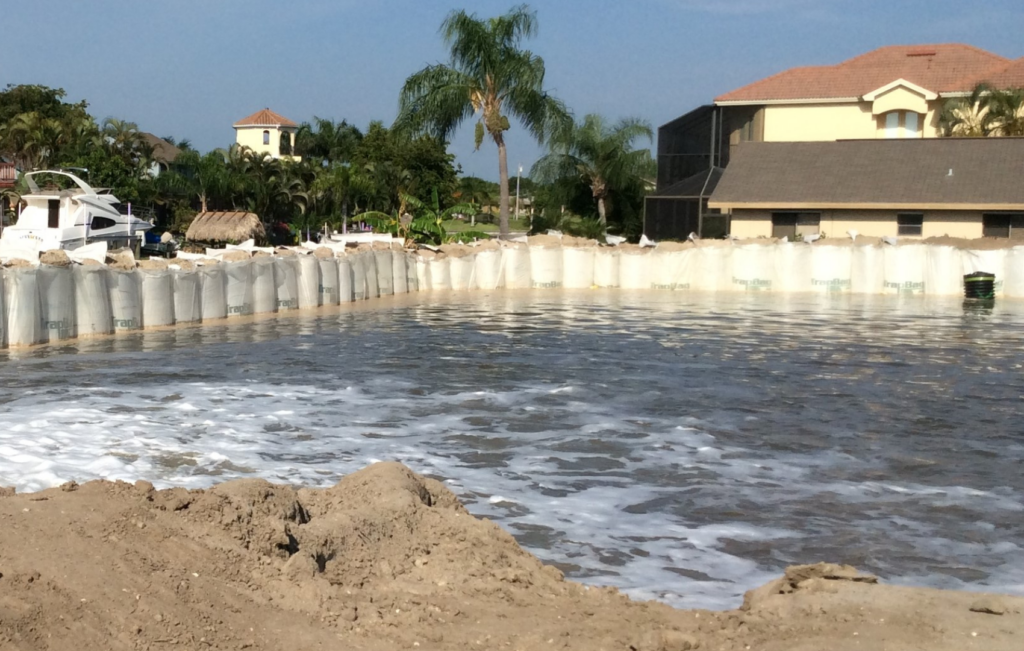Preventing Dam Failure by Learning from the Past
Dam failures happen every year, leading to dangerous, expensive consequences. Ensure your dam is properly protected in the event of a failure with TrapBags.

Dam failures happen every year. While some lead to more minor damages, many have led to catastrophic outcomes, claiming lives, causing extreme property damage, and leaving communities struggling to repair. Along with investing in reliable flood protection and dam support, municipalities can learn from previous dam failures to prevent their own communities from experiencing the same disastrous outcomes.
What Happens When a Dam Breaks?
Dams are created to control water for a variety of reasons—generation of electricity, to be used as a water source for nearby residences and industries, or for local irritation. When a dam breaks, a large amount of water rushes forth in a powerful gush and can quickly lead to devastating consequences, including death, property loss, erosion, and economic loss. When a dam breach occurs, it can leave a community in shambles for months.
Causes of Dam Failure
Dam failure occurs as a result of many different factors, some being more controllable than others. These can include:
- Climate change: Climate change has led to an increase in unpredictable and extreme weather events. Abnormally heavy rainfall can lead to overtopping, which occurs when water levels exceed the expected amount and weaken the integrity of the dam’s spillway.
- Improper planning: If a dam is constructed on an area with an already unstable or sloped foundation, there is a much higher chance of the dam’s foundation cracking as the ground below naturally shifts. It is the responsibility of engineers to ensure the location of the dam is solid enough to hold an enormous amount of weight and pressure under any conditions, and to place necessary reinforcements in the area as time goes on.
- Dam condition: As dams age, they may begin to wither. Upkeep and maintenance is necessary, as without it, small issues can continue to worsen and eventually lead to a breakage. There are over 94,000 dams in the U.S., with an average age of 53+ years. States are responsible for regular dam inspections to prevent failures. Still, The Association of State Dam Officials estimates that there are over 15,000 dams considered to have high-hazard potential if they were to fail—it would cost $24 billion to rehabilitate these dams to make them safe to the public.
- Debris blockages: Dams can become backed up and fail if clogged with debris like tree branches or trash.
Dam Failures in the U.S.
Each state in our country has experienced dam failure. Before dam safety laws, dam failures were more severe and deadly, though in recent years, some states have still experienced serious repercussions as the result of a dam failure.
St. Francis Dam Failure
On March 12, 1928, in Los Angeles, California, the St. Francis dam, a two-year-old concrete gravity dam built as a storage reservoir, suddenly failed. 47 million cubic meters of water was released into San FrancisQuito Canyon. More than 400 people lost their lives.
The self-taught engineer of this dam, who had limited experience with concrete dams, was largely to blame for the catastrophic failure. There was definite improper planning in this dam construction—the plans for the dam were not site-specific, and the height of the dam was increased twice throughout the build, though it impacted the overall potential safety of the dam significantly. It is noted that the foundation on which the dam was built was weakened by the engineer’s actions.
In this instance, the engineer and his team picked the wrong sort of dam for the site they had chosen to construct it on. While not around in 1928, TrapBag barriers could have been filled with cement and placed at the dam’s foundation where the majority of the issue occurred. Strengthening the base may have been enough to alleviate the amount of pressure on the area. In another effort to mitigate the effects of the flooding, TrapBag barriers could have been placed as a precautionary measure, diverting water to a more appropriate place, saving the lives of the civilians who were killed.
Edenville Dam & Sanford Dam Failure
On May 19 and 20, 2020 in Midland, Michigan, two dams failed, leading to the evacuation of 10,000 people; the destruction of roads, bridges, and over 2,500 homes and businesses; at least $175 million in damages; and economic distress for the community who relied upon the two lakes the dam failure dried up, Wixom and Sanford.
The Edenville dam was constructed in the early 1920s and many of the construction specifications were not done properly. The dam had been built on embankments of loose sand and too steep of downstream faces, which caused too much pressure to be placed on certain parts of the dam—the parts that ended up failing. While government officials did many structural analyses of the dam over the years, it was determined that the tests conducted were not thorough enough to identify the poor soil conditions that led to the failure. Due to heavy rainfall in the days leading up to the dam failure, the lake levels were higher than normal, but not to levels that had dam operators overly worried at the possibility of failure.
Similarly to the events of the St. Francis dam, the disastrous, costly effects of the Edenville and Sanford dam failures could have been significantly reduced with the help of TrapBag barriers. TrapBags are incredibly durable when used as a diversion wall, water containment reservoir, levee, or dam. If they had been situated on the perimeter of the dam, TrapBag barriers could have diverted water away from the city of Midland.
South Fork Dam Failure
In Johnstown, Pennsylvania, in 1852, a rock-fill dam was constructed to be used as a water source for the Pennsylvania Canal. Ten years later, due to a combination of improper construction (a significantly smaller spillway was created in comparison to what was in the original plans) and poor maintenance upkeep, a portion of the dam collapsed and washed out.
The dam was repurchased in 1879 and altered to fit the endeavors of the new owners, who sought to convert the lake into a private resort with the help of the dam. One of the alterations included lowering the dam, which would prove to be a deadly mistake.
In 1889, a record rainfall poured over the area for over 24 hours. Upon noticing how high the water level of the lake had become, dam crew attempted to release some of the water through the spillway, which was found to have been clogged with debris and fish traps. The wall below was continuing to erode, and the crew attempted to stabilize it with mud and rock to no avail. The dam collapsed and destroyed all in its wake, including homes, trees, and even a 78-ft railroad bridge. When the flood waters made the few mile trek to Johnstown and other nearby towns, it claimed the lives of over 2,200 people and left 30 acres of debris in its wake.
The alterations made to the dam post-1879, including the lowering of the dam’s height and the reduction of the spillway, are ultimately what led to the disaster. Proper precautions considering the safety of the nearby towns were not in place if the dam were to have failed. TrapBag barriers filled with concrete and stacked for height could be used in this situation as a barrier, diverting water and dangerous debris from reaching low-lying areas and the civilians residing there.
Teton Dam Failure
The Teton dam was an earthen dam constructed by the Bureau of Reclamation in eastern Idaho in between 1972 and 1975, designed to control spring water runoff and to be used as a water source in the drier months of summer.
On June 6, 1976, during its first time being filled, the dam failed. It began as a large leak and toppled as it finished filling, allowing 400,000 cubic meters of water to flood nearby homes, businesses, and farmland. In addition to claiming the lives of 14 people, the flood caused over $400 million in property damages.
It was later discovered that the main cause of the dam failure was due to its position on a highly permeable foundation, which led to cracking. This area needed to be properly treated prior to the dam being constructed, or further stabilized with permanent forms of support. TrapBag barriers are durable when utilized in this manner, and can also be used to divert water to precautionary water containment basins in the event of a dam failure event.
Prevent Dam Breaches with TrapBag Barriers
TrapBags barriers are an engineered form of flood protection that can be deployed as flood barriers in a variety of situations, including dam failures. TrapBags are an industry leader in flood protection thanks to their incredible durability, consistent reliability, ease of deployment, and affordability.
TrapBags as Dams
TrapBags can be utilized to reinforce existing dams. They can also be situated in a variety of structures to divert water from threatened areas. Different types of TrapBag configurations include:
- Infrastructure support: TrapBag barriers can be placed in or around dams as a form of leak-resistant stabilization to prevent floods during heavy rainstorms, mitigating extensive damage, expensive repairs, and loss of employment.
- Dams & levees: Reliable dams are crucial in the event of natural disaster-induced flooding. TrapBags can be arranged to block and redirect water, saving communities costly repairs later. Levees are water barriers that prevent floodwaters from infiltrating elevated surfaces, like roadways and agricultural plots. The leak-resistant structure of TrapBags makes them the ideal solution for protecting people and property during a dam break.
- Diversion walls: During floods that occur after a dam breaks, displaced earth can smash into infrastructure, commercial properties, and homes, injuring people and leaving structural damage in their wake. TrapBags can be filled with concrete to build sturdy, protective walls that block and divert debris, keeping people and their property safer.
Beneficial Properties of TrapBags
TrapBags are the superior form of flood protection in the event of a dam failure.
- Versatile: TrapBags are made to be filled with sand or washed gravel when used temporarily, but can also be filled with concrete to form a permanent flood barrier. They are easy to stack to create taller, wider structures when necessary.
- Durable and dependable: Created from a high-strength geotextile material, TrapBags are made to last at least five years after deployment. The accordion-style structure of the bags ensures leaks are non-existent, even if a singular cell is compromised.
- Affordable: TrapBag barriers are a more cost-effective flood wall solution—they require 40% less fill than traditional sandbags.
- Easily installed: The accordion-style structure of TrapBags makes deploying them a quick task—no grabbing, transporting, and stacking individual bags one by one. Save time when it’s most important with TrapBag.
Keep Dam Breaks at Bay with TrapBag
Don’t become a case study for future engineers to study on dam failure—strengthen your dams, and protect your community from floods during dam failures with TrapBags. Send us a message today to learn more.[/vc_column_text][/vc_column][/vc_row]
Meet the author
Get the Dirt Before the Flood Hits
Stay ahead of flooding, erosion, and disaster response challenges. The Dirt, TrapBag’s monthly newsletter, delivers field-tested tips, real-world case studies, and the latest in barrier technology straight to your inbox.

